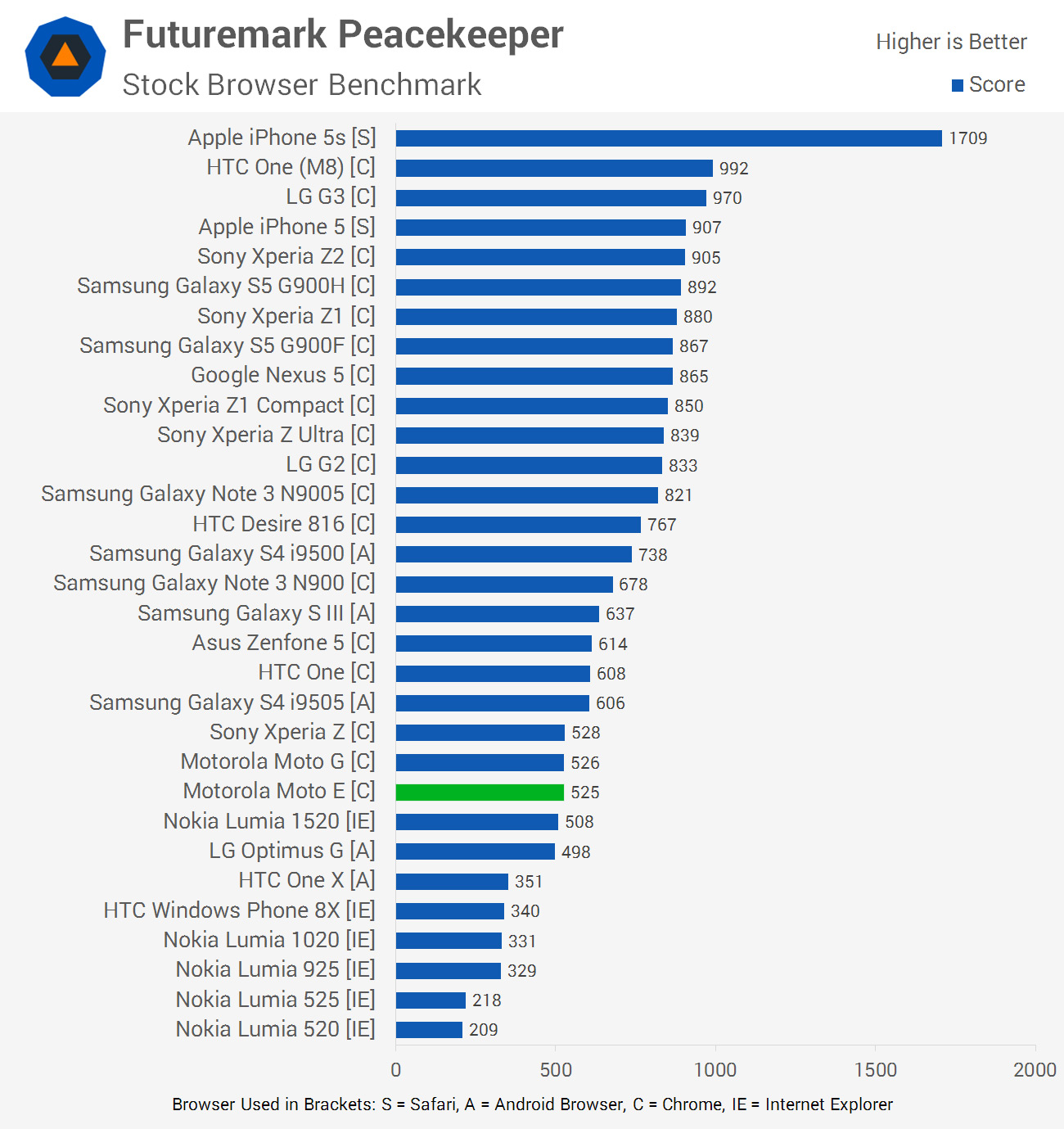Motorola Moto E Smartphone Review > Performance: A Capable Snapdragon 200
Functioning: A Capable Snapdragon 200
Equally the Moto E is an entry-level handset, it's no surprise to see the device packing a Qualcomm Snapdragon 200 SoC. This detail line of fries is the cheapest Qualcomm produces, and the 28nm MSM8610 found in this handset is a natural progression downwards from the mid-range Snapdragon 400 found in the Moto M.
The MSM8610 includes two ARM Cortex-A7 CPU cores clocked at upward to 1.two GHz, and an Adreno 302 GPU clocked at 400 MHz. Interestingly, CPU-Z indicates the Moto Due east features an Adreno 305 GPU, however both Motorola and Qualcomm'due south documentation indicates it's actually the Adreno 302, and whatsoever they say is nigh likely right.

If you lot want a comparison between this chip and the Snapdragon 400 MSM8226 found in the Moto G, there are essentially ii differences: the CPU core count has been reduced from four to two (the cores are of the same type and clocked at the same frequency), and the slightly slower Adreno 302 replaces the Adreno 305. Everything other aspect is, on paper, identical.
Besides included equally function of the Moto E's base hardware is 1 GB of LPDDR2 RAM, which I'm glad has been included instead of a paltry 512 MB. There'south too iv GB of internal NAND, expandable through the device'due south microSD card slot, and the usual connectivity options including Wi-Fi 802.11b/one thousand/n, Bluetooth 4.0, and HSPA+ supporting download speeds up to 21 Mbps.
During my fourth dimension with the Moto E, the performance from the entry-level device is quite acceptable. The general operating system experience is oftentimes shine, non equally smooth as a high terminate device where animations are rendered hands at threescore FPS, just perfectly serviceable. Occasionally you get spots of lag, although it only seems to happen soon after switching apps or heading back to the homescreen.

This occasional lag shows ane weakness of the Moto East, and that is multi-tasking. Functioning in any one app can be quite proficient, merely switching betwixt apps exposes the slowness of the SoC in opening apps and loading data. Information technology doesn't seem like RAM is the issue, with virtually apps being resumed rather than reloaded, rather raw processing speed letting it down. I shudder to retrieve how the Moto East would perform with only 512 MB of RAM at its disposal.
With all that said, I oasis't seen a single entry-level device that excels at switching between multiple apps, because it's something you'd purchase a higher-terminate device for. The Moto East is designed to provide a bones nevertheless solid smartphone experience, and in that respect, I'yard very satisfied with its general performance.
Below I've included the full suite of benchmarks for the Moto E, which betoken that in benchmarks which only use two or fewer CPU cores, you'll get identical performance to the Moto Thousand with its Snapdragon 400 SoC. Largely, the Moto Eastward displays entry-level performance as you'd expect.





Next up are the GPU benchmarks, where again we see entry-level performance from the Adreno 302. Equally it only has to bulldoze a qHD brandish, gaming performance can actually be decent, and you won't find many problems running 3D games that are supported on the smartphone. Note that not all major titles can be installed on the Moto E; Mod Combat v is 1 such example.



And finally we have the NAND performance results, which again bear witness the Moto Due east is an entry-level device.


The chart I'yard most excited to present – new to this review – is the 1 below, which ranks some of the devices I've recently reviewed in terms of functioning and toll. I've calculated a weighted score that reflects the overall performance of the device, and and so divided that by the outright cost of the device. The weighted score takes into account CPU, GPU and NAND operation, but not the other features of the smartphone.
Handsets that provide bang-up performance for the price are ranked highly in this chart, and could be considered the all-time value. Conversely, devices ranked in the lower part of the chart could be too expensive. This ranking should hopefully give a better analogy of how devices compare if yous consider both cost and performance.

We can besides deduce from the chart what cost a device should be to attain the best value. For example the LG G3 has a score per dollar 1 unit lower than other flagships at $560, however at $540 it sits roughly equal. Value differences are amplified at lower price points: setting the Asus Zenfone five at $210 gives it a value on par with flagship handsets, but bring it down to $170 like it retails for and suddenly it'due south v units better value.
On the Motorola Moto East specifically, it tops the charts. This is because although flagship smartphones outperform the Moto E by a gene of effectually two-iii, depending on the benchmark, they generally toll over 4 times equally much. This makes the handset, at to the lowest degree on performance, undeniably good value.
Ane expanse of the Moto Eastward that's not so expert is the internal storage. four GB with 2.17 GB bachelor to use out of the box is slim pickings for app installs, although being able to expand on the storage through a microSD bill of fare treats some of the pain.
Source: https://www.techspot.com/review/862-motorola-moto-e/page2.html
Posted by: cruzwhicess.blogspot.com


0 Response to "Motorola Moto E Smartphone Review > Performance: A Capable Snapdragon 200"
Post a Comment